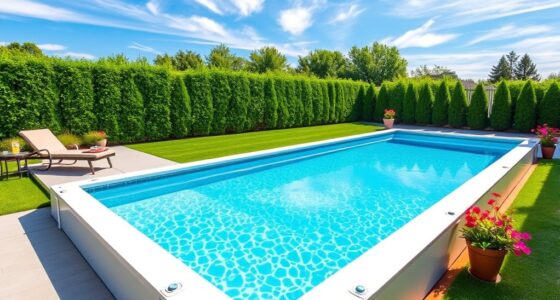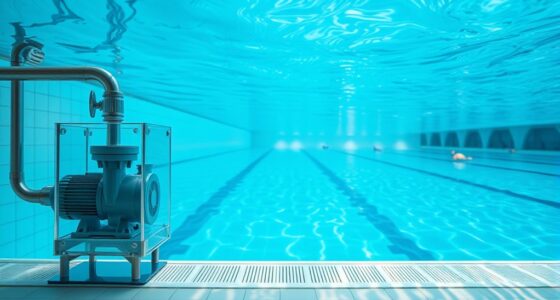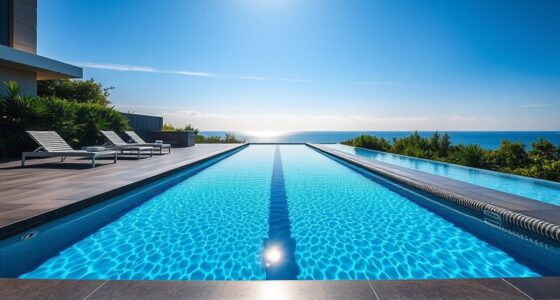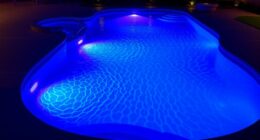A lap pool typically costs between $20,000 and $50,000 for a basic in-ground model, depending on size, features, and installation complexities. Your expenses will include excavation, materials, and labor, with added costs for custom options like heating or high-end finishes. Keep in mind that ongoing maintenance, utilities, and potential upgrades also affect your long-term budget. To plan effectively and make the most of your backyard oasis, it’s helpful to contemplate all these factors as you explore options.
Key Takeaways
- Installation costs typically range from $20,000 to $50,000, depending on size, features, and site preparation.
- Ongoing maintenance expenses are usually between $500 and $1,000 annually for chemicals and cleaning.
- Utility costs for pumps and heaters can add $50 to $200 monthly, depending on usage and climate.
- High-end features and custom designs increase upfront costs but may reduce long-term expenses through durability.
- Budgeting should balance initial installation with ongoing maintenance and utility costs for a sustainable backyard pool.

Are you wondering how much it costs to install and maintain a lap pool? Building a backyard oasis is an exciting idea, but understanding the financial aspects upfront helps you plan better. The installation costs can vary widely based on several factors. For a standard in-ground lap pool, you might expect to spend between $20,000 and $50,000. This range includes excavation, materials, and labor. If you opt for custom features like advanced lighting, heating, or high-end finishes, costs can climb considerably. Conversely, choosing a basic design with fewer bells and whistles can help keep expenses down. Keep in mind that site preparation, permits, and landscaping can also add to the initial investment.
Once your lap pool is up and running, you’ll want to think about maintenance expenses. Regular upkeep is essential to keep your pool clean, safe, and functional. Chemical balancing, filter replacements, and routine cleaning typically cost around $500 to $1,000 annually. If you hire a professional pool service, expect to pay about $100 to $300 per visit, depending on the size of your pool and the frequency of service. Additionally, ongoing costs include electricity for pumps and heaters, which can range from $50 to $200 per month, depending on usage and local energy rates. If you choose a heated pool, your utility bills will be higher, but you’ll enjoy more comfortable swim conditions year-round.
The longevity of your lap pool also influences overall costs. Proper maintenance extends the lifespan of your investment, reducing the need for costly repairs or replacements down the line. For example, investing in high-quality equipment initially might seem more expensive but can save you money in the long run. On the other hand, cutting corners on installation can lead to more frequent repairs and higher maintenance expenses over time. It’s wise to budget for periodic upgrades and potential repairs, especially if you’re considering a pool that’s built to last with durable materials. Being aware of pool features & accessories can help you select options that enhance durability and reduce long-term costs.
In total, budgeting for a lap pool means balancing your upfront installation costs with ongoing maintenance expenses. While the initial investment can seem steep, proper planning ensures your backyard will become a sustainable, enjoyable retreat. Take time to research your options, get multiple quotes, and think about long-term costs. Doing so will help you create a beautiful, functional lap pool that fits your budget and lifestyle, making your backyard a true personal haven.
Frequently Asked Questions
What Are the Maintenance Costs for a Lap Pool?
You’ll find that maintenance costs for a lap pool mainly come from pool chemicals and cleaning frequency. Regularly balancing chemicals like chlorine and pH levels keeps the water safe, which can cost around $50 to $100 monthly. You’ll also need to clean the pool frequently—brushing, skimming, and filtering—adding to expenses. Overall, expect to spend a few hundred dollars annually on upkeep, depending on usage and pool size.
How Long Does It Take to Install a Lap Pool?
Installing a lap pool typically takes about 4 to 8 weeks, depending on your pool size and installation timeline. Larger pools or custom designs may extend the process, while smaller, standard models usually come together faster. You’ll work with your contractor to guarantee proper site preparation, permits, and construction align smoothly. Keep in mind, factors like weather or unexpected delays can influence how long your new lap pool takes to be ready for use.
Are There Financing Options Available for Lap Pools?
You’ll find plenty of financing options and flexible payment plans for lap pools. Many pool companies offer these options, making it easier for you to afford your backyard oasis without paying upfront. You can choose plans that fit your budget, often with low interest rates or deferred payments. Be sure to ask your installer about available financing options, so you can enjoy your lap pool sooner without financial stress.
What Permits Are Needed for Installing a Lap Pool?
Think of building a lap pool as maneuvering a well-charted map; permits are your compass guiding safe passage. You’ll need to check local construction regulations and pool safety codes, which vary by area. Securing permits guarantees your project is legal and safe, preventing future issues. Contact your city or county office to understand specific requirements, and always follow these guidelines to keep your backyard oasis secure and compliant.
How Energy-Efficient Are Lap Pools Compared to Traditional Pools?
Lap pools tend to be more energy-efficient than traditional pools because they often incorporate eco-friendly features like energy-efficient pumps and LED lighting. Their streamlined design reduces water and energy waste, cutting down on overall energy consumption. Plus, you can add solar heating options to further enhance their eco-friendliness. With these features, you’ll enjoy a healthier, more sustainable swimming experience while saving on energy costs long-term.
Conclusion
A lap pool isn’t just a backyard feature; it’s a reflection of your dedication to wellness and serenity. As you invest in its construction, you’re planting seeds of health and tranquility that grow with every swim. Your backyard becomes a sanctuary where water whispers promises of renewal and strength. Remember, this pool symbolizes more than leisure—it’s a personal retreat where your spirit can find balance and peace amid life’s chaos.









